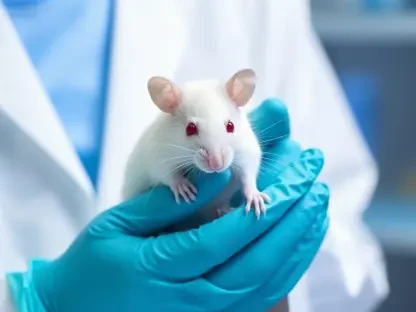In a chilling development for healthcare systems across the United States, a dramatic increase in multidrug-resistant bacteria known as carbapenemase-producing carbapenem-resistant Enterobacterales (CP-CRE) has emerged as a formidable challenge in hospitals, often dubbed a “superbug” due to its resistance to numerous antibiotics. CP-CRE poses a severe threat to patient safety, particularly in clinical settings where infections can spread rapidly among vulnerable populations. Data from a comprehensive network tracking antimicrobial resistance across 29 states reveals a staggering rise in the incidence of these dangerous pathogens. This surge not only underscores the evolving nature of bacterial resistance but also highlights the urgent need for enhanced strategies to combat this growing public health crisis. As hospitals grapple with the implications, the complexity of treating such infections continues to escalate, demanding immediate attention from medical professionals and policymakers alike.
Rising Incidence of a Deadly Superbug
The numbers paint a stark picture of the escalating threat posed by CP-CRE in American hospitals, with a reported 69% increase in age-adjusted clinical cultures over a recent four-year period. This alarming trend, derived from extensive surveillance data, signals a significant shift in the landscape of antimicrobial resistance. The rise is not merely a statistical anomaly but a reflection of the growing challenge in managing infections that defy conventional treatment. Hospitals, often the epicenter of such outbreaks, face mounting pressure to contain the spread among patients who are already immunocompromised or critically ill. The data indicates that this superbug’s prevalence is becoming a widespread issue, affecting a substantial portion of the population across multiple states. As resistance patterns evolve, the healthcare community must confront the reality that standard protocols may no longer suffice against such resilient pathogens, pushing the boundaries of medical intervention to new limits.
Beyond the sheer increase in cases, the specific drivers of this surge reveal an even more troubling dimension of the CP-CRE crisis. A staggering 461% spike in strains carrying the New Delhi metallo-beta-lactamase (NDM) gene has been documented over the same timeframe, marking a dramatic shift in resistance mechanisms. Unlike earlier dominant strains, NDM-producing bacteria resist even the latest antibiotics designed to tackle carbapenem-resistant infections, rendering many modern treatments ineffective. This development complicates clinical decision-making, as healthcare providers struggle to identify suitable therapies in the face of such robust resistance. The rapid ascent of NDM strains, now rivaling other historically prevalent carbapenemases, underscores a critical need for updated approaches to infection control. As this superbug continues to adapt, the implications for patient outcomes grow increasingly dire, emphasizing the urgency of addressing this evolving threat with innovative solutions.
Challenges in Treatment and Resistance Mechanisms
Treating CP-CRE infections presents a formidable hurdle for medical professionals, largely due to the high mortality rates associated with these infections and their prevalence in hospital environments. Historical estimates suggest that carbapenem-resistant Enterobacterales have caused thousands of cases and hundreds of deaths annually in U.S. healthcare facilities, highlighting the severity of the issue. The ability of carbapenemase genes to transfer between bacteria amplifies the risk, facilitating the rapid spread of resistance within and beyond hospital walls. This genetic adaptability creates a moving target for clinicians, who often find themselves outpaced by the bacteria’s evolving defenses. Compounding the problem is the lack of timely testing capabilities in many clinical labs, which hinders the ability to tailor treatments to specific resistance profiles. Without swift and accurate diagnostics, patients face delayed or ineffective care, exacerbating the already significant burden on healthcare systems.
Another layer of complexity arises from the growing diversity of carbapenemase types, which demands a more nuanced approach to therapy. While some newly approved antimicrobial agents target specific carbapenemases, they often fall short against emerging strains like those carrying the NDM gene. This mismatch between available treatments and resistance mechanisms leaves clinicians with limited options, particularly as the once-dominant Klebsiella pneumoniae carbapenemase (KPC) declines in prevalence, giving way to more resistant variants. The dynamic nature of this resistance landscape calls for a deeper understanding of local epidemiology to inform treatment decisions. Experts stress that integrating carbapenemase-specific testing into routine clinical workflows is essential to ensure patients receive targeted therapies. Until such measures are widely adopted, the gap between diagnostic capabilities and therapeutic needs will continue to widen, posing a persistent threat to patient safety and public health.
Urgent Steps for a Safer Future
Looking back, the rapid rise of CP-CRE, particularly strains with the NDM gene, marked a pivotal moment in the battle against antimicrobial resistance in U.S. hospitals. The significant 69% increase in incidence, coupled with a dramatic 461% surge in NDM-producing strains, underscored the urgency of addressing this public health crisis. These developments, observed across a broad network of states, revealed the limitations of existing treatment and diagnostic frameworks in the face of evolving bacterial threats. The decline of previously dominant resistance mechanisms like KPC further highlighted how quickly the landscape of infection control could shift, leaving healthcare providers scrambling to adapt to new challenges. This period served as a stark reminder of the relentless adaptability of superbugs and the critical need for proactive measures.
Reflecting on these challenges, it became evident that actionable solutions were imperative to curb the spread of CP-CRE. Enhancing access to rapid carbapenemase testing stood out as a key priority, enabling clinicians to make informed treatment choices swiftly. Additionally, fostering a deeper understanding of local resistance patterns could guide more effective infection control strategies, tailored to specific regional needs. Collaboration between healthcare facilities and public health agencies was also crucial to monitor and respond to emerging threats in real-time. Investing in the development of novel antibiotics and alternative therapies offered a long-term path to outpace bacterial resistance. By prioritizing these steps, the medical community could build a more resilient defense against superbugs, ensuring safer hospital environments and better outcomes for patients facing these formidable infections.









